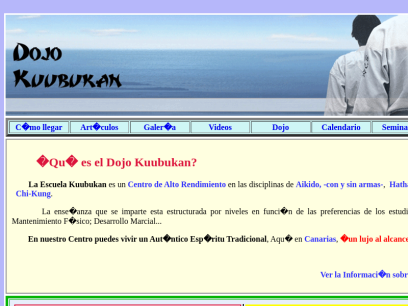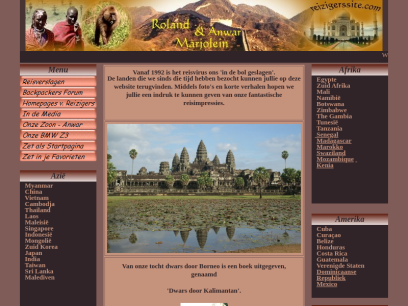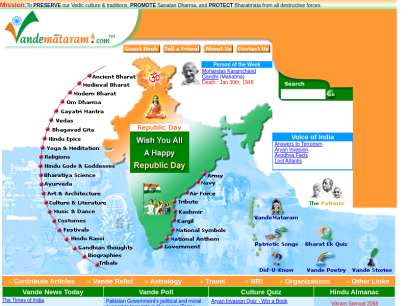index
Tribute site to the entertainment career of Sajid Khan. Sajid was the first actor/singer from India to star in a national U.S. tv show, MAYA, and to have his own records in the 1960's. He starred in such films as Mother India, Son of India, Heat and Dust.

Stats
Alexa Rank:
Popular in Country:
Country Alexa Rank:
language:
Response Time: 0.282214
SSL: Enable
Status: up
Code To Txt Ratio
Word Count 39
Links
ratio 5.8134998049161
SSL Details
SSL Issuer:
Issuer: R3
Valid From: 2022-05-13 22:34:29
Expiration Date: 2022-08-11 22:34:28
SSL Organization:
Signature 9bb828aebad33768442297d7ef04ca3531672049
Algorithm: RSA-SHA256
Found 49 Top Alternative to Sajidkhan.com

 Dojokuubukan.es
Dojokuubukan.es
Dojo Kuubukan. Aikido en Canarias, Isla de Tenerife en El Sauzal España Spain Europa
La Escuela Kuubukan es un Centro de Alto Rendimiento en las disciplinas de Aikido, -con y sin armas-, Hatha-Yoga, Meditación y Chi-Kung. La enseñanza que se imparte está estructurada por niveles en función de las preferencias de los estudiantes: Calidad de Vida. Mantenimiento Físico. Desarrollo Marcial... En nuestro Centro puedes vivir un Auténtico Espíritu Tradicional, Aquí en Canarias, ¡un lujo al alcance de tú mano!

 Reizigerssite.com
Reizigerssite.com
Reizigerssite - De Backpacksite van Roland, Marjolein & Anwar
Reisinformatie, reisverhalen, veel foto´s over onder anderen Azie, Amerika en Afrika

 Animaster.com
Animaster.com
Animaster Design College | School Of Design| Bangalore|India
Join the best Design College in India. University accredited design courses. Real World education only at Animaster, School of Design, Bangalore

 Vandemataram.com
Vandemataram.com
VandeMataram.com - Learn about Indian Civilization, Culture, Yoga, Ayurveda,History,
Vandemataram.com reveals Ancient History of India from Vedic to modern times. The users will learn about the secret wisdom of Sanatan Dharma, Saraswati civilization, Art & literature, Ayurveda, Science, Astronomy, Dance, Music, Vedic Culture and Religion, Temples, Festivals, Cooking, Yoga, and everything related to the sacred land India. Vandemataram.com provides free Email service, Chat rooms, Discussion Forums, Poetry postings, Speak Out, e-Greetings, News, Polling, and several other services to it's users. It also highlights Hindu contributions to the world through its Did-U-Know channel. Bharat-Ek-Quiz channel will test the users mind on what they know about Ancient India.

 Atleest.com
Atleest.com
15% Penji Coupon Code (Verified) - High Quality Graphic Design Services
Find 15% Penji Coupon Code here! Get your design projects done successfully from Penji, that offers quality design services. Grab Penji Coupon

 Bonuspointstutoring.com
Bonuspointstutoring.com
Bonus Points Tutoring
Welcome to Bonus Points Tutoring! Bonus Points Tutoring is a premiere private educational organization. We believe every student deserves the best opportuni

 Swaminarayan.nu
Swaminarayan.nu
The Original - Swaminarayan Sampraday
www.SWAMINARAYAN.NU is about The Original Swaminarayan Sampraday consist of Vadtal and Ahmedabd gadi as established by Lord Swaminarayan Him-Self. The website contains Shree Swaminarayan darshan, names of both gadi acharya, uniqueness of Swaminarayan Sampraday.

 Ezawaj.com
Ezawaj.com
eZawaj.com
زواج زواج مسيار مسلم زواج اسلامي Muslim and Muslim Arabs and Christian Arabs matrimonials from all over the world,articles about Nikah, and more.

 Viaggiareliberi.it
Viaggiareliberi.it
Viaggiare Liberi
Viaggiare Liberi, Michele Spiriticchio, viaggiare, viaggiare liberi, free travelling, travel stories, storie di viaggi, recensioni di viaggio, diari di viaggio, anunci di viaggio, compagni di viaggio, mappe, maps, mapas, C'è chi vuole tutto dalla vita e chi non vuole niente...


 Atlan.org
Atlan.org
Atlan.org - Atlantis: the Lost Continent Finally Found. - by Prof. Arysio Nunes dos Santos
A pleasant village lies at the surface of the ocean. May its king be merry and enjoy splendid feasts, Up to the time when the sea turns fierce and bold… A wave will suddenly cover the entire region… A pleasant village, full of people, lies over a lake, A fortress impregnable, surrounded by the sea. -Book of Taliesin, Poem 21 Atlantis! Few words evoke a deeper sense of wonder, of mystery, and of an utter, irreparable sense of loss than the name of the Lost Continent. And this type of feeling has lasted since the times of Plato, the great philosopher who wrote about some two and a half millennia ago, at the time when Greece was still the main center of culture in the Western World. But is it a sheer myth? A moral fable? Or actual history somehow restored to the realm of reality by the prince of philosophers? Many thousands of books have been written on Atlantis during the twenty-five centuries that elapsed since Plato’s time. However, the matter of Atlantis is far from exhausted. In fact, the mystery of its whereabouts has never yet been satisfactorily settled, despite the hundreds of different locations so far proposed for it just about everywhere in the world: the whole Mediterranean region; the North Sea; the Atlantic coasts of Europe and Africa; the mid-Atlantic region, the Americas, and so forth. Actually, the experts on the subject have even been unable to decide whether Atlantis really existed or was no more than a measly figment of Plato’s imagination; a moral fable devised by the philosopher in order to provide an ethical background for the ideal utopic republic he had imagined in his other dialogues, the Republic above all. Some prefer the middling line and conclude that Plato’s report on the Lost Continent is a wild exaggeration of normal, everyday events. Accordingly, they propose that Plato’s Atlantis was in fact the same as Minoan Crete, or Mycenaean Greece, or Hissarlik’s Troy, or the island of Cyprus, or some other petty Bronze Age civilization turned into a veritable Paradise by the magic pen of the great sage. But the fact is that if we remove the wonderful element of Plato’s narrative we are left with essentially nothing. Few of us, if anyone, is really interested in the trivial demise of a small culture that was born and disappeared somewhere, leaving little or no imprint of its former existence. After all, such disappeared cultures range in the thousands nowadays. Nevertheless, Atlantis is clearly an exception to this rule. To believe Plato, Atlantis was the mother of all civilizations. Atlantis was a vast empire of continental size and worldwide extension, which mastered navigation and naval commerce; invented metallurgy and stone-dressing, and excelled in the arts and offices of all sorts, including dance, theater, music, and sports. Moreover, the Atlanteans amassed such a mass of wealth that Plato affirms that “it is like was never before possessed by kings and potentates and is not likely ever to be again”. Said otherwise, Atlantis was the same as Eldorado and Golden Cipango; as the fabulous Ophir of King Solomon and as the paradisial land of Havilah, “where gold was born”. The mere mention of its name sufficed to set the minds of the early adventurers aflame with gold fever. Notwithstanding their wealth, the Atlanteans were noble, virtuous people, who despised riches and only pursued wisdom and piety. In time, however, they decayed from grace and grew ambitious and covetous. The gods, gathered in a council, decided to punish them so that they might again improve. For this purpose, they sent cataclysmic floods and earthquakes, and unreservedly destroyed the place, which became a sort of scarecrow to all who misbehaved in a similar way. To be sincere, the story of Atlantis strikes me as being closely similar to a dozen others told in the mythologies of all peoples, the Judeo-Christian one in particular: the story of Sodom and Gomorrah; the one of the Flood; the fall of Adam and Eve and of Lucifer, and so forth. The Celts also had very similar traditions on sunken places, witness the poem of Taliesin quoted in epigraph. Homer too tells a similar story of the Phaeacians and of the dire punishment of their disobedience by Poseidon, their patron god, and founder. Ghostly Phaeacia closely evokes Atlantis, in Homer’s quaint description. Even the Incas of South America have similar stories on the Atumurunas, the fallen giants who were punished and exterminated by the Flood due to their sodomitic habits. Plato himself identifies the Atlantean cataclysm with the Universal Flood. And he also adds several interesting details which unequivocally lead to the conclusion that this cataclysm was triggered by giant volcanism attended by ground subsidence and caldera formation; pumice release; giant tsunamis and earthquakes, and so forth. We will return to this theme later, in the main text. Moreover, the date was given by Plato – the one of 11,600 BP [Before Present] – exactly coincides with the one of the end of the Pleistocene Ice Age, as well as of the so-called Meltwater Pulse 1 B [MWP1B]. Both of these geologic phenomena were giant cataclysms of global import and catastrophic consequences far larger than the recent tsunami which afflicted disaster-prone Indonesia, killing in excess of 400,000 people, according to the most recent estimates. Since such global geological events do not often occur, we are compelled to apply Ockham’s Razor to them all and to try to unify them all into a single event. Said otherwise, it seems that the cataclysm of which Plato speaks is actually the same as the one of which all sacred traditions in the world also do. There are literally hundreds of legends on the Flood and on Paradise Lost in essentially all cultures of the world, both primitive and advanced. The fact that such legends also diffused to the New World bespeaks of their hoary antiquity. In fact, according to the standard doctrines currently taught in essentially all academies the world over, contact between the Old and the New World ceased soon after the end of the Ice Age, when sea level rose, closing the Beringian Passage, the sole possible communication between the two worlds. Since the legend in question unequivocally reached the New World from the Old, the only way in which this diffusion might have happened was via Beringia. And this means the contact was done during the Ice Age or soon after before that passage became definitively closed. We are hence led to conclude that this legend, if it is in fact sheer legend, or this reality, if it is reality, actually dates from the very epoch in which it is said to have taken place, that of the catastrophic end of the Ice Age. Said otherwise, it seems that Plato well knew what he was talking about, and was in fact inventing nothing at all. It is only recently that the reality of geologic and climatic cataclysms of global import has become accepted by academic experts specializing in these disciplines and in related ones, for instance, Evolution, Paleoanthropology, Anthropology, Paleontology, and so forth. Nowadays, the evidence of Catastrophism has become overwhelming, and cannot be denied anymore even by the die hardest academics and experts of all sorts. Until recently, the possibility that continents can sink was unanimously rejected by all sorts of specialists, the geologists in special, as we argue in more detail in the main text. But we have managed to show that this view, though still current, is false, and have actually demonstrated that a huge sunken continent – truly “larger than Libya (North Africa) and Asia (Minor) put together” just as Plato affirmed – actually exists in the region of Indonesia and the South China Sea, in the East Indies, the true site of Atlantis-Eden. Indonesia, the Remnants of Sunken Atlantis In fact, the myriad islands of Indonesia are the mountain tops and highlands of the sunken continent which remained emmersed when sea level rose and its lowlands foundered, at the end of the Pleistocene Ice Age, some 11,600 years ago. This is the exact date given by Plato in his dialogues on Atlantis. And Ockham’s Razor requires us to unify these cataclysms, as we just argued. Actually, this region of the world has been little explored down to the present date. The geologists have based themselves on the results they had gotten for the Atlantic Ocean and the Mediterranean Sea, the only ones which they have really studied thus far. But all such generalizations are fraught with perils of all sorts, just as the philosopher Hume warned us. Said otherwise, Induction is not a valid procedure, both philosophically and scientifically speaking. The negative results the scientists had obtained for the Atlantic Ocean or the Mediterranean Sea – where no sunken continents of even islands of any substantial size could ever be found – does not entail that different conditions might not prevail in either the Indian or the Pacific Oceans, not to mention the others such as the Arctic and the Antarctic Oceans. The fact that the specialists all gave up then, instead of looking further is a highly telltale of the myopic views of the Western scholars, who firmly believe that Civilization originated on their side of the world, and nowhere else. The reality is that deep under the waters of the Indo-Pacific Ocean – and more exactly, at their very divide – there lie the remains of a sunken continent of huge size, just as reported by Plato in his two dialogues on Atlantis, the Timaeus, and the Critias. We have had the honor of discovering this sunken continent in Indonesia and of charting it out for the first time ever some twenty years ago, far before other would-be researchers started claiming the same discovery, which they very obviously only did in my own detailed writings on the subject. Otherwise, how are we to account for the fact that no one ever discovered the true whereabouts of Atlantis – or, for that matter, of Eden and similar Paradises – before I actually did so. And then, all of a sudden, a host of researchers independently started getting the very same results which took me so many years and so much effort to compile, interpret, and coordinate? Besides, standard scientific ethics – which these amateurs obviously ignore – requires that, even in the remote hypothesis of an independent rediscovery, credit and recognition be given to the first person to publish, in this case, myself. My results have been amply divulged not only on the Internet itself but also in books, in the media, and in the scientific journals of all sorts decades prior to their own claimed finds, made all of a sudden and literally taken off their tall hats of illusionists. The sunken island-continent I discovered in the region of Indonesia – for such is literally the meaning of the world nêsos actually used by Plato – is true of enormous size, as can be seen in the maps of the region which I present in my Atlantis site and elsewhere in the present book. We might in fact call it a “New World” (Mundus Novus), much as did Amerigo Vespucci when he finally realized that the “islands” discovered by Christopher Columbus were in fact a formerly unsuspected continent, the world’s Quarta Pars (“Fourth Part”). We might, along the same lines, call this new Indonesian continent the world’s Quinta Pars (“Fifth Part”), the fifth continent, the one which completes the quincunx so often embodied in the symbolism of Mt. Meru. Actually, the new world I discovered is also the same as the Taprobane of the ancient traditions, also known by traditional names such as Terra Australis Incognita, Antichthon, Antilia, Antipodes, Antiporthmos, and so forth. These names all mean the idea of “Counter-Earth”, more or less as does the one of Atlantis itself. And the knowledge of their reality dates from time immemorial. We will be discussing these matters in more detail in the main text, and their discussion does not fit here. But the fact is that these fabled lands were deemed to be far more than a sheer myth. Such was particularly the case with Taprobane, known as the site of Hades and the “Otherworld” (Mundus Alterius) ever since the times of Alexander, and even before. However, the glory of discovering Atlantis-Eden and its true location and reality is not really mine, after all. All I did was to study the sacred traditions of many peoples until I was really able to discover what they were all about: Greek, Roman, Egyptian, Mesopotamian, Phoenician, Amerindian, Hindu, Buddhist, Judeo-Christian, and so on. In time they all started to make sense. And it was from them that I finally realized the true location of Paradise as well as the reality of the Universal Flood and the correct nature of the geological phenomena which triggered the event. The rest of the task was comparatively easy. All I had to do was a sort of “reverse engineering”, looking for the scientific data which supported and explained the ancient traditions. The biggest difficulty I had to face was the utter incredulity and the ostracism of all my colleague scientists and even of the public in general. The public is trained from infancy to believe the voice of authority alone instead of the hints of everyday commonsense and discernment. So, they tend to rely on their teachers and other such experts, rather than on novel discoveries which menace to disrupt the solid edifice of lies on which both Science and Religion are nowadays founded. Returning to Indonesia’s sunken continent. In contrast to this region of the world, the Atlantic Ocean and the Indian are strewn with volcanic islands such as the Azores and the Canaries, which rise directly from the seafloor. These islands generally belong to the Mid-Oceanic Ridge. As such, they rise rather than sink and never were a part of any sunken continent or even large islands. This, in contrast to what most of the earlier Atlantologists naively believed: Ignatius Donnelly, Lewis Spence, Pierre Termier, Mme. Blavatsky and several others. Said otherwise, the origin of these ridges and these islands is nowadays fully explained by Plate Tectonics Theory. They are rising from the seafloor, rather than sinking into it in any possible way. The islands there are mere volcanic peaks formed from basaltic magma characteristic of the seafloor material and are in no way associated with continental material, generally silicic in nature. It was this realization that led to the widespread disbelief of scientists concerning the possibility of Atlantis ever having been located in these regions of the world. The same thing holds in relation to the Pacific Ocean, where similar conditions prevail. So, one may also say goodbye to Pacific continents such as Lemuria and Mu, at least in the terms argued by Mme. Blavatsky, Col. Churchward, and W. Scott-Elliot, among several others. The only exception to this geological rule seems to be the region of Indonesia itself. This region lies at the intersection of three Continental Plates which are converging into the region, creating enormous stresses on earth’s crust. The result is that the crust is locally pushed up, forming extensive shelves (the Sunda Shelf, etc.) and several mountain ranges of impressive altitude. These shelves are rather shallow, and become exposed (subaerial) during the Ice Ages, when sea level drops by well over a hundred meters. This happened during the last Ice Age, the times when Atlantis flourished, according to Plato’s detailed report. This whole region is very prone to huge earthquakes and explosive volcanism, which often result in major disasters, well attested in the geological record. The recent lethal tsunami is only the latest of a whole series extending throughout history and prehistory, as attested in the geological record of the region. This tsunami was only 10 meters or so in height. Imagine the destruction caused by a mile-high wave of the type described in a great many legends of the Flood the world over. The region of Indonesia forms the boundary or divide of the two great oceans, the Pacific and the Indian. During the Ice Age, the whole region was exposed, forming a vast continent attached to Southeast Asia and the Malay Peninsula (formerly called Taprobane). When sea level rose by 130 meters or so, the very extensive lowlands of the Indonesian shelf became definitively submerged and permanently disappeared under the sea. Only the highlands and the volcanic peaks remained emersed as some sort of mute witnesses of the cataclysm. And these highlands and volcanic peaks became the myriad islands of Indonesia, a name which means something like “insular India”. The scant survivors were forced out and moved to India proper and other places such as Southeast Asia, China, Polynesia, the Americas, the Near East, and so forth. Eventually, they reached Europe and other Far Western locations. The Word “Island” in Plato We believe that the word “island” used by Plato (nêsos) actually refers to the islands and the region of Indonesia itself. The Greek word bears a sense of “submerged land” and apparently corresponds to what the Hindus call dvipa. This noun refers to paradisial lands now sunken, very much as was also the case with Atlantis. And the word is generally translated as “island-continent”, given that the Hindu dvipas are also said to be of continental size, just as was the case with Atlantis. Actually, both the Latin word insula and its Greek counterpart nêsos ultimately derive from the Dravidian inču meaning “watery land, marsh”. According to Diodorus Siculus, Atlantis sunk away in the Tritonides Marshes, a remarkable disclosure tending to confirm this conclusion of ours. And this region was often identified to the former location of the Garden of the Hesperides (or Atlantides), another well-known metaphor for Atlantis-Eden itself. The Greek word nêsos underwent metathesis (inču >*niču > *nêsu > nêsos). But this Greek word is visibly the same as the Latin and the Dravidian forms. The Dravidian origin of both the word and the myth cogently suggests a Hindu origin of the whole myth of Atlantis. And we also note that the Sanskrit word dvipa literally means “two waters” (dvi-ap), a strange acception at best. We believe that, rather than meaning “having water on two sides”, as so often affirmed, the real reference here is to “two levels of water”, one exposed and prevailing during the Ice Ages, and the other one submerged and prevalent in the Interglacials such as the present one. But this is just a mere hypothesis, offered here as food for thought for our dear readers. No matter what, it is now becoming quite clear that a great civilization developed in this vast equatorial region of the world during the Ice Age, at least to believe Plato’s detailed disclosure or those made by several other ancient authorities, both classical and otherwise. Among these other Classical authors referring to the story of Atlantis, we mention Diodorus Siculus, Theopompus, Homer, Hesiod, Virgil, and several other Greek and Roman mythographers and rhapsodes. And we also have the similar sacred traditions of essentially all peoples on earth which use other names but that clearly refer to the same location, the sunken continent of Atlantis-Eden. To believe these ancient traditions, this great civilization spread to several distant regions of the world, eventually becoming an empire of worldwide extension. It is only thus that we are able to explain the diffusion of agriculture, stone-dressing, metallurgy, religion, and, above all, of language and the alphabet which, as we have managed to show, embody unequivocal traces of having a common origin in the sacred tongues of India such as Sanskrit and Dravida. For instance, the first letter of the alphabet is called aleph (or alpha, etc.). And this word closely evokes the name of the elephant (Elephas, in Greek) and, above all, of Ganesha, the elephant god whose name is by the Hindus placed at the start of any undertakings whatsoever. We also note that the shape of the Greek alpha: α – the Greek counterpart of the aleph – closely evokes not a bull, but the head of a bull elephant with its tusk sawn off (like Ganesha). So do, by the way, the earliest forms of the Semitic aleph. These pieces of evidence could be multiplied at will. And they all show that the standard academic views on the development of Civilization are utterly in error. We well realize that these uncanny claims may seem vaunted and even impossible to most people, both experts and lay. But we are prepared to prove these assertions. And we have in fact done so in several detailed documents we have produced during the many years of detailed research which we have dedicated to the problem of Atlantis and which we plan to publish soon. It was from the “seeds” planted by the survivors of the cataclysm – the civilizing heroes, gods, and angels of which all traditions speak – that the great civilizations of the historic and the prehistoric past ultimately arose: the Indus Valley Culture, Egypt, Mesopotamia, Hatti, Greece, Minoan Crete, Rome, the Incas, Mayas, Aztecs, and so forth. It is certainly more than a coincidence that all these pristine civilizations speak of these pristine civilizers, instead of claiming for themselves a glory that is well deserved. In one form or another, all these peoples also speak of Paradise as the cradle of Mankind and of Civilization. How could they all independently invent the same myth, as unanimously affirmed by today’s scholars? And the ancients often use names that closely assonate with the one of Atlantis, another uncanny coincidence: Atlantis, Tala, Attala, Atala, Patala, Talatala, Thule, Tollán, Aztlán, Aztatlán, etc… Moreover, these names often mean “the Land Antipodal”, an etymology preserved in names of mythical lands and continents such as Antilia, Antichthon, Antiporthmos, Antoeci, Antichthon, etc… What this means is that the ancients well knew that Paradise Lost was located on the opposite hemisphere, on the other side of the earth. As such, they often referred to Paradise as being located on either the Farthest West or the Farthest East. Given the fact that the earth is round, one side is actually coterminous with the other, and hence vicinal and actually common. This region of the world really corresponds to the one of Indonesia, the actual divide both of the Ocean and of the two hemispheres of the earth: East and West. It was there that, in antiquity, the day started by convention and, hence, the place where the sun was born every day. And it is at least curious that the ancients would develop such a sophisticated concept unless they somehow had a need for it. And this need bespeaks of the reality of an international empire of worldwide extension, one capable of roving the world’s countries and oceans. What else? The “White Island” of the Universal Traditions on Paradise Indonesia was also identified with the so-called “White Island”, the actual name of Paradise in several ancient traditions. This name corresponds to the one of Sveta-dvipa (or Saka-dvipa), the paradisial “White Island” of Hindu traditions. It was there – in this “island of the whites” – that the white races (sakas) originated, in the dawn of time. These Sakas were also called Yavanas (“Whites”). The Yavanas are the same as the Ionians (or IaFones, as in Homer). And this name – which is alternatively spelled Javanas – actually derives from the one of the islands of Java, one of the main Indonesian islands. Another of their names was “Ethiopians”. The name of the Ethiopians was facetiously interpreted as meaning “burnt-faces” by the ancient Greeks. But it really meant “purified by fire”, as explained in the ancient Hindu sacred texts on the agnishvatthas (“purified by fire”). This ethnonym normally designated both the Berbers and the Libyans of North Africa. But it also applied the other white races of the Far East (Indonesia), the Tocharians in special. Homer already referred to “the Pious Ethiopians, located one half in the Far East, where the sun rises, the other half in the Far West, where it sets”. These Eastern peoples were the “blond Chinese” of Pliny and Solinus, the “Long-Lived Ethiopians” of Herodotus, and so forth. In actual terms these Ethiopians correspond to the Tocharians, the Avars, the Sakas, the Hephthalites, and other such “White Huns”. Long considered an idle invention on the part of the Classical writers, the reality of these “white Ethiopians” cannot be doubted any longer. Their well-preserved mummies have recently been discovered in great numbers in the deserts of Mongolia and the Tarim Basin region, the site of the Chinese province of Xinjiang. Some of these mummies are so perfectly preserved that their red or fair hair and even their blue eyes and tall stature can still be observed in perfect detail. And so can their wool clothes, often consisting of tartans quite like the ones of the Irish and other nations of Celtic Britain. It is perhaps worth remarking that the word “tartan” ultimately derives from Tartary (Tatary or Mongolia), attesting that in earlier epochs, this type of tissue came from the Far East, being in all probability produced by these peoples, the Seres or Tocharians. These White Huns were also called Hephthalites, a name of obscure meaning and origin, perhaps related to the one of Naphtali, the son of Jacob. This Hebrew word means “wrestler, warrior”, and perhaps alludes to the role they had as mercenary soldiers in the Indian and other Far Eastern courts, Chinese included. But this is mere speculation, which is unessential to our argument here. No matter what, this type of onomastic evidence leaves little room for doubting the Far Eastern origin of the white races, probably from (Far Eastern) Atlantis itself. From there these survivors eventually passed to Southeast Asia, and then to China, and finally to Europe and the Near East. The name of “White Island” is, as usual dual in meaning. It refers both to the fact that the white races originated there and that this land was purified by fire so that their denizens might improve and be restored to their pristine piety. Said otherwise, we see that these peoples are the same as the Pious Ethiopians and, even more exactly, the Atlanteans in their pristine, undecayed purity. The name of the “White Island” is frequent in the traditions of many peoples. The Hindus called it Sveta-dvipa or Saka-dvipa, as we just argued. And they also referred to their denizens as pitris (“dead ancestors”) or, more commonly, as agnishvatthas. This name refers to “those who sat too near the fire” and got burnt by it, becoming purified, more or less as happens to gold. The “fire” in question here is of course the mighty volcano of Indonesia, the ferocious Krakatoa which conflagrated the whole region of Indonesia in the dawn of time. And it is of course the same as the one which scorched the Ethiopians, the Berbers, and the Libyans, as well as other such white or red races originary from the Far East. Many of these peoples were in fact restored to piety, just as seems to have been the case of the Tocharians and the Celts, to name just two. But most persisted in their vices and their barbarism. Such seems to have been the case with the barbarous Berbers and the Yüeh-chi, a name that also means “barbarian” in Chinese. This name often applied to the Hsiung-nu, the same barbarians known in the west as “Huns”, and as Huna in ancient India. The name of the Yüeh-chi also seems to be related to one of the Jewish people, if one observes the close assonance of the two ethnonyms. These “barbarians” made persistent attacks against the Chinese, who were forced into building the famous Chinese Wall to protect themselves. The word “barbar” ultimately derives from the Sanskrit and refers to the “balbutiating” tongue these barbarians spoke. And this name invariably applied to the speakers of Dravidian-based tongues such as Berber (Tamazight), Guanche, Etruscan, Pelasgian, and so forth. The Great Wall of China was built by the Chinese in order to protect themselves from the periodic, unprovoked raids and attacks of these ferocious nomads and their Mongolian associates. Some experts even link these bellicose peoples with Gog and Magog, also said to have lived in the very same region of the world, as attested in the Alexander Romances. We also encounter the name of “White Island” or “White Land” in the one of Sukhavati, the Western Paradise of Buddha Amitabha. Its western location of course implies the idea already argued that it is placed at the world’s divide, between the East and the West. Sukhavati literally means “abounding in delights”. But these “delights” are in fact sweetmeats, the Sanskrit word sukha playing with śukra (“sugar, white”), of which it is a corruption. Ultimately, the meaning of the name of Sukhavati plays with the one of Kandhava (“candy bar”), another name of Paradise Destroyed in the ancient Hindu traditions. The name of Aztlán, the Aztec Paradise, is also said to mean “land of purity”; “white land” by several experts. And the same is also true of Yvymaraney, the “Pure Land” or Paradise of the Tupi-Guarani Indians of Brazil. The Navajo Indians of North America also refer to a White Island in connection with Paradise, as I comment on my Atlantis site. And so did the ancient Greeks with the Leukades (“White Islands”), which they too equated with Paradise Destroyed. This list could be increased further. But the above should suffice to prove the diffusion of this myth of Paradise Lost to essentially all places of the world: India, China, Tibet, Mongolia, America, Europe, and so forth. And, as we already argued, this universal diffusion could only have happened in Pleistocenic times or shortly after, when the Beringian Passage was still open. How else? Plato’s Atlantis as a Tropical Paradise It is true, as several researchers have argued, that Atlantis was in fact located to the west of Gibraltar, very much as Plato affirmed. But the philosopher did not specify how far to the west. In fact, Plato apparently meant the far shore of the Ocean which, to the ancient Europeans, included the Pacific Ocean and invariably meant the East Indies. Even though Plato may be ambiguous in his statement of this fact – actually a double entendre – Diodorus Siculus is very explicit on this subject. And so were the ancient Celts, who invariably sited Paradise on the far bank of the Ocean, in Defrobani (Taprobane) itself. We argue this issue in more detail in the main text, and will not delve into it here any longer than that. But we must also keep in mind the “western” location of the Paradise of Buddha Amitabha, as well as the western route chosen by Christopher Columbus when heading to the East Indies. Columbus’ belief was based on many ancient authorities, and should not be easily dismissed. And it is a fact that the farthest west is coterminous with the farthest east, so that both lie in one and the same location, at “the farthest fringes of the world”. Nor should we forget the detailed references and quotations we make when discussing this seminal issue further below in the main text of the present book. It is this type of overlooking obvious facts that have led to the persistent failures of all or most Atlantologists so far, who insist on looking for Atlantis in the vicinity of Gibraltar as if Plato’s words could not be interpreted otherwise. Moreover, it is important to keep in mind the fact that the ancients – the mendacious Phoenicians in particular – created a whole lot of phony Atlantises just about everywhere in the world, the region of Gibraltar in particular. These phony Paradises mainly served to confound the competition about the real source of the precious merchandise they peddled to the west: the East Indian commodities such as ivory, precious woods, metals, gemstones, dyes, drugs, perfumes, and so forth. Besides, the secret location of Paradise’s remains also served to prevent the greedy profanes from desecrating the sacred place, the site of Eden turned in the much-feared Hades, the Land of the Dead. Only the initiates knew its true to be in Taprobane, also the site of the Otherworld of the Hindus and the Islands of the Blest of the Greeks, the Celts, and the Phoenicians, among others. In his dialogues on Atlantis – the Timaeus and the Critias – Plato left us such a convincing description of the paradisial place that few people are able to believe that he was inventing or even embellishing some more ordinary everyday events and locations. Though Plato’s texts are unfortunately short and his planned trilogy was left unfinished, the two pieces left both abound in detailed geographical and geological facts, in precise dates, in architectonic details, and so on. Anyone who reads Plato’s texts on Atlantis – a few dozen pages only, and widely available on the Internet, even in the Greek original – will probably become convinced that they cannot but refer to anything other than the description of a land that once existed. Plato’s Atlantis is a tropical paradise abounding in all sorts of wonders and riches: extensive plains and beautiful dales and mountains; gemstones and metals of all sorts, both precious and common; smelly woods, perfumes, and dyes of a high price; abundant waters and irrigation canals; most productive agriculture; golden palaces and silvery walls and citadels Plato also speaks of temples of unsurpassed riches and beauty, and of hoards of gold and jewels which no other nation would ever match. When we look closer into this matter, it is easy to realize that most of this precious merchandise was characteristic of the East Indies. Even more so, these precious merchandises were characteristic of Indonesia, itself the site of the “Spice Islands” or Moluccas, which caused the brows of the ancient sailors to burn with gold fever. It is strange that no researcher ever pointed out this close parallel before. Perhaps people are all blinded by the obsession that “if it is Atlantis, it’s gotta be located somewhere in the Atlantic Ocean”. But the fact is that we must clearly understand what the ancients really meant by names such as “Ocean of Atlantis”, the real name of this ocean or sea. And, as I just argued above this name encompassed both the Atlantic Ocean proper and its two main extensions, the Indian and the Pacific Oceans of modern times. In antiquity – and down to the times of Columbus himself – the modern Atlantic Ocean was considered the Pacific’s eastern extension, and the Indian Ocean its eastern extension. Actually, we demonstrate this fact with both actual maps and ancient texts such as the well-known world chart owed to Eratosthenes, the famous Greek geographer. We discuss this issue in more detail in the figures section of the present book, where they can be perused by the interested reader. As reported by Plato, the mighty empire of Atlantis came to a sudden end in the course of their great war against the pristine Athenians. And these were apparently allied to other nations such as the ancient Egyptians, the other Greeks, and other peoples. During the course of these combats, the ground caved in – probably due to giant volcanism – and opened up, engulfing the two contending armies en masse, as reported by Plato. All this happened “in the course of a single night and a day of pain and horror”, according to the great philosopher. In consequence, the whole island sunk away and disappeared permanently under the waters of the sea. Ever since that time – some 11,600 years ago, as affirmed by Plato – Atlantis has lain on the bottom of the ocean that once bore its name. But this name was later transferred, through a series of mistakes and confusions, to the water body that now bears it and is located between Europe and Africa on one side, and the Americas on the other. The disappearance of Atlantis was so thorough and so complete that even its former existence became utterly forgotten. But its memory survived in the oral sacred traditions of all or most peoples on earth, the Egyptians, the Greeks, and the Hindus in special. And it fell to Plato to restore the legend to the realm of reality, perhaps basing himself on the secret traditions of the Mysteries. These secrets were only told to the initiates themselves, vowed to secrecy under the risk of death in case of profanation. This crime – called “impiety” – consisted in divulging to the profanes the real contents of the secret of the Mysteries. And a great many people paid this type of profanation with their lives. The most notorious of these were Socrates and Cicero, who both paid with their lives. Even Plato himself had to flee Athens in order to escape the death penalty. And so also Aeschylus, Seneca, and Aristotle, to name only a few. It is quite likely that the anti-Atlantis stance of most scientists and intellectuals ultimately derives from this ancient legislation which somehow seems to be still in force today one way or the other. With the advent of Christianity, this sort of ferocious censorship was pursued by the Holy Inquisition and its many counterparts everywhere. In a way, the “heresy” of people such as Leonardo da Vinci, Giordano Bruno, Tommaso Campanella, Pico de la Mirandola, Galileo Galilei, and a host of other such intellectuals of the Renaissance was connected with the theme of Atlantis. It all started, in the Renaissance, with the foundation of Plato’s Academy in Florence by Marsilio Ficino and Pico de la Mirandola. And this revival of Classicism eventually led to the proposals of adventurers such as Christopher Columbus and other heirs of the Gnostic traditions who well knew that the remains of Paradise Lost were located in the East Indies. These traditions were best preserved in Portugal and Spain by the Knights of the Order of Christ and other such secret movements directly derived from Catharism and the Knights Templar. But this is a sensitive theme that ill-fits this book, and which is better left for a more congenial opportunity than the present one. However, no one who really studies the story of Christopher Columbus and his “accidental” discovery of America will fail to realize the obvious fact that he was inspired by the ancient reports on Golden Paradises such as Marco Polo’s Cipango; Plato’s Atlantis; Solomon’s Ophir; the fabulous Atlantic Islands of the medieval geographers, and so on. And, as we just said, the great Renaissance explorer never doubted that these fabulous islands or partly sunken continents lay in the East Indies, the butt of all his navigations. No matter what, no wise academic or skilled professional ignores that the theme of Atlantis is taboo, and can only be treated with scorn and haughtiness, in the negative. Very few, if any of them are willing to risk their careers, their posts, and the cozy grants they get in order to pursue this type of tabooed research, ill-seen by the whole community. And who has ever heard of a serious scientific expedition being mounted or funded by scientific or academic institutions or governments in order to research Atlantis and its seas? Their justification – no one ever admits cowardice as a reason – is that the very possibility of accepting the reality of Atlantis would inevitably result in the need of a thorough revision of human sciences such as Anthropology and History, not to mention the many ancillary disciplines such as Linguistics, Archaeology, Evolution, Paleoanthropology, and perhaps even Religion itself. These disciplines are all neatly separated in several different isolated niches, and hardly interact one with another anymore. So, they never come in conflict among themselves, a very comfortable assurance to all who labor in teaching or in research, as I did for so many years before I finally retired in order to dedicate myself fully to the research of Atlantis-Eden. Well, it now seems that the story of Atlantis is finally completing the full circle and returning to the very start. If the fertile plains and the golden temples and palaces of Atlantis really existed – as affirmed by Plato and Diodorus, among others – they must exist somewhere on earth, either below the ground or beneath the waves of the ocean More hopefully, some remains of Atlantis will be found in the highlands of the great empire, the ones which remained emerse after the great cataclysm of the end of the Ice Age that caused its enduring demise. And if they exist, they can be found, as long as we start looking in the right places, instead of the wrong ones, as we have all been doing so far. My discovery of Atlantis’ true location and of the actual geological mechanism which caused the submersion of the Lost Continent in the Great Flood is admittedly only a start. But every trip, no matter how long, starts with the first step, as Lao Tzé once affirmed. I took that first stride. And I hope that at least some of my readers will bear with me and read my words attentively and with no disdain. Atlantis has gained a lot of public recognition lately. A great wave of new books and researches – some valid and serious, some no more than scams intended to make a fast buck – have recently been published on the subject of Atlantis. And its name is now very often in the press and in the media, as is easy to verify directly. The Internet has about ten million sites bearing the word “Atlantis” or its equivalents in other languages (Atlántida, Atlântida, Atlantida, Atlantide, and so forth). And its myth has undergone a revival, perhaps stirred by my own publications on the issue. My Atlantis site on the Internet alone has received over 2.5 million visits in the last few years since it was posted there. In the course of the past 12,000 years or so which have elapsed since the end of the Ice Age, we humans have again managed to rebuild Civilization, essentially from scratch, so utter and so global was the destruction triggered by the Atlantean cataclysm. Of course, the “seeds” left us by Atlantis-Eden greatly speeded the process of recovery. The first time of course took a far greater lapse of time. In the past two centuries we humans had the luck of discovering a great many lost civilizations which had left no visible records nor visible remains: Troy, the Indus Valley Culture; Sumeria; Tartessos; Angkor, Minoan Crete, and so forth. Some of these were only mentioned in the mythological records and were found by researchers who took the ancient traditions as verbatim fact. And why would the traditions on Atlantis-Eden as the site of the Terrestrial Paradise be false if they are told over and over again by essentially all peoples on earth? Why would the ancients all lie, if they should far more likely attempt to appropriate the seminal discoveries such as Agriculture and Metallurgy as their own, had these discoveries really been done by their own people? Quite likely, the interest in Atlantis is fostered by an instinctive belief that we humans are something more than mere beasts of the field which deserve little more than the daily swill, the panis et circenses of which the Roman rulers spoke with flagrant despise. Perhaps it is true that we humans indeed came from Paradise in the very distant past, and just forgot our divine origination there. And perhaps we just stumbled and fell, more or less like Adam and Lucifer and other such decayed gods and heroes. But are again ready to get up again and resume the path that leads to the more heavenly pursuits of which Plato and other ancient sages spoke. Or, perhaps, we are all getting scared that the cataclysm which once was may be again. No one can sanely deny anymore that the world now stands at the edge of destruction due to hubris and arrogance no lesser than the one of the Atlanteans themselves, one that drives us all into endless wars and endless greed. The Quest for Lost Atlantis Now Viable In the last few decades, the search for the vestiges of Lost Atlantis has become a far more promising prospect than was ever possible in the past. We now possess scuba-diving equipment which allows the exploration of the shallower sections of the sea. We also have far more realistic views on Catastrophism and on Evolution which are a far cry from the Victorian doctrines of Darwin and Lyell. These foolish, Panglossian doctrines unfortunately are still prevalent in the academic curricula of all nations on earth. But they fast falling in general discredit and will be soon trashed, I am sure, despite the ferocious opposition of reactionaries of all sorts. And so will a host of current academic disciplines founded on a host of outright lies dating from Victorian times, so-called “splitterism” in special. Their sole, exclusive intention was the one of providing a pseudo-justification for Colonialism and other such now obsolete doctrines. We humans also now have wholly new scientific equipment such as ROV Cameras, Sidescan, and Multibeam Sonars; Miniature Subs and well-equipped Oceanographic Ships and even Outer Space Satellites which allow us to film or map the oceanographic bottoms down to any depth and to any scale one might possibly desire for the quest of elusive Atlantis. So, all that is needed is to put this formidable paraphernalia to the service of a good cause instead of merely using them for purposes such as warfare and espionage. Again, human or geological sciences such as Oceanography, Geology, Climatology, Seismology, Anthropology, Linguistics, Paleoanthropology, Comparative Religion, and Mythology have made enormous strides over the last decades despite the usual conservatism of their academic masters. Hence, they and other such disciplines may now be put to the service of Atlantis. The study of sunken coastlines, of the shallower marginal seafloors, and the new equipment such as the research sonars just mentioned have revolutionized the whole proposition. These techniques became so precise, that they are now used to prospect for ancient shipwrecks and to hunt for submerged treasures, including objects as small as metal coins, statues, and ceramic vases such as amphorae. Within the last few years – perhaps fostered by my own researches on the subject – the whole subject of Atlantology has again gained a considerable reputation both among the public and even inside some academic circles. Certain Greek scholars of a high reputation are in the process of organizing a worldwide conference of the reality of Atlantis, and have already obtained the adhesion of a great number of participants from all over the world, myself included. As is clear, the whole situation is currently changing. The pieces of the gigantic jigsaw puzzle bequeathed by our elders are finally starting to fall in place. It is true that the completion of the pattern, the crowning piece, so to say, would be the finding of submerged temples, palaces, walls, statues, roads, and other archaeological artifacts which could be reliably dated and ascribed to Atlantis itself and no other civilization or colony of later epochs. But this will only occur when we start looking into the right spots, rather than in the wrong ones, as up to now. It is a pity that so many researchers cry “Atlantis” or “Eureka” whenever any piece of rubble or any impossible artifact, real or not, is found, either on the ground or at any depth. These finds are often unfeasibly deep, as is the case of Sarmast’s Cyprus and Zelitsky’s Cuba, to name just two. But these obvious frauds are fast exposed and are hence short-lived in the media. We have ourselves unequivocally located some archaeological artifacts on the shallow seas of the Indonesian region, some discovered from outer space by NASA’s spy satellites, some from the surface by more local methods. So clear are they that we are currently starting to organize an oceanographic expedition to their site, in order to take a closer look. We want to run no risks of over-optimism. And we do not want to risk having sensationalists or ambitious treasure-hunters rushing to the place and claiming my finds as their own, as has unfortunately already happened in the past. Some people are extremely greedy. And the mere mention of the words “Atlantis” or “Paradise” is sufficient to set their brows burning with gold fever, just as it did in the times of Columbus and other conquistadors. We beg our dear readers to be patient, just as I have been myself. I well know that it is frustrating to have to wait until reliable evidence develops. But it is better this way. Better than being frustrated by false finds and false claims, as has been so often the case with Atlantis. Dozens of sites and dozens of evidence sunken or not have been discovered over the past years off the coasts of Florida, Mexico, Cuba, Venezuela, the Bahamas, the Bermudas, and so on. The same is also true even of India, where very promising sites and artifacts have been discovered by Indian archaeologists: in Dwarka, in Mahabalipuram, and other coastal locations. The same is also true of Spain and Portugal. Even remote Japan – this specific spot quite near my own Far Eastern site – has yielded submarine features which many mistakes for artificial, but which are no more than mere geological artifacts of a natural origin. These alleged finds are all illusions and have not withstood the test of time or of a more thorough scientific research. The essential parameters are date and depths. If the objects can be dated – and they generally can, if really authentic – the date has to be consonant with the Pleistocene ones of Plato. And their depth has also to be correct and lie at around 50 meters or so, the dates which correspond with the ones given by sea-level rise. All the rest is a sheer illusion and must be not be consumed unless they come to be verified and validated in some independent way. If these two crucial parameters – time and submersion depth – are not respected, the artifact must be dismissed as a priori impossible by all serious researchers, unless some reliable explanation is offered for the discrepancy. And this has to be compelling enough to convince the scientific community at large if we in fact want to earn both their respect and their recognition. Scientific recognition is difficult if not impossible to get. But is normally required, unless the find is so compelling and so unequivocal as to be irrefutable by itself. As is clear, what was once deemed sheer legend is fast turning into actual scientific fact, given the recent advances in marine archaeology and in reliable radiocarbon dating, etc.. We can only anticipate that even more remarkable finds will be made in the forthcoming years, now that the true location of Atlantis is known for sure, at least by the many adepts of my theory. That these finds and these advances could be of crucial importance to mankind, no one doubts anymore. They would force us to change what we now take to be the whole prehistory of mankind and, above all, the stupid notion that our ancestors were all semi-morons incapable of any advance down to the catastrophic end of the Pleistocene and the start of the Neolithic Age, a mere 10,000 years or so ago, as if by some sort of magic. And why is that? Why would all human advancement be stymied for the millions of years during which humans have existed and, above all, for the last million years, when we humans have existed in essentially the modern form of Homo sapiens? The a priori odds against this event are overwhelming. And the explanations so far offered are all essentially stupid and scientifically untenable. One such is that Agriculture was actually impossible during the Ice Age, and hence never developed till this age was over. But this is now known for sure to be false. The Chinese researchers have now demonstrated by actual archaeological finds that rice agriculture developed in the Far East as early as 15,000 years ago, and probably much more than that. They also managed to show that natural rice cropping started as early as 35,000 years ago, and probably far more. So, it is now archaeologically proved that, in contrast to what is presently held in the West, Agriculture first arose in the Far East, rather than in the Near East. And this is the very region where I found Atlantis-Eden to have flourished during the Ice Age. As is clear, the evidence keeps piling up. And a great many sacred traditions on the rise of Agriculture speak of Paradise, the Garden of Eden. And this garden was obviously a cultivated region, just as its name implies. The word “garden” implies a “cultivated ground”, a “grove”. It is very probable that most traces of this early agriculture have been effaced by the Flood, or permanently buried under the sea. This happened at the end of the Ice Age, when sea level rose by an enormous 130 meters, flooding all coastal locations on earth for a width of 200 kilometers and even more. But these sunken locations may still be found when we start to look in the right spots, particularly under the seas of Indonesia and the vicinal spots. Once this fact is realized, these prehistoric locations will start to be found, as is already starting to happen in China, Japan, Korea, India, Indonesia, and elsewhere. The next step would consist in attempting to learn to communicate with the ancient Atlanteans and to really understand the sacred messages they bequeathed us in their myths, their rites, and their holy books. We must abandon the current misconception that Civilization of necessity arose in the Mediterranean region, either in Atlantic coasts (Atlantis) or in the Near East (Eden, Sumer, Egypt, Greece), etc.. This myopic Western preconception is only due to ethnocentric reasons and is hence wholly unscientific. And it must be definitively abandoned by all scholars, academic or not before any real progress on Archaeology becomes possible. –Written By Prof. Arysio Santos in Jan. 2004

 Dobandar.com
Dobandar.com
dobandar.com
The domain has expired and may be available at auction. If this is your domain, you can still renew it. Register or transfer domains to Dynadot.com to save more and build your website for free!

 Girijanavikas.com
Girijanavikas.com
HOME | GIRIJANA VIKAS
Girijana Vikas Swatchanda Seva Samstha shortly called as Girijana Vikas. With an inspiration by a Village Development Officer, Mr.N.V.Satyanarayana with a group of like-minded friends from G.K.Veedhi & Ramagedda villages has promoted this institution during 2001

 Motalakat.com
Motalakat.com
ÇáãæÞÚ ÇáÚÑÈí ÇáÇæá ÇáãÎÕÕ áÕÝæÉ ÑÌÇá æÓíÏÇÊ ÇáÚÑÈ ááÒæÇÌ ÇáÔÑÚí æÇáÚÑÝí æÇáãÓíÇÑ

 Khabarharpal.com
Khabarharpal.com
HugeDomains.com
khabarharpal.com is for sale Please prove you're not a robot View Price Processing

 Rednetz.com
Rednetz.com
The Domain Sale - Find the right domain for your business
We help your business find domain names that are individual and relate to your products and services.
Technologies Used by sajidkhan.com
Dns Records of sajidkhan.com
A Record: 173.254.30.233AAAA Record:
CNAME Record:
NS Record: ns2.justhost.com ns1.justhost.com
SOA Record: root.just2005.justhost.com
MX Record: mail.sajidkhan.com
SRV Record:
TXT Record: v=spf1 +a +mx +ip4:173.254.28.14 ?all
DNSKEY Record:
CAA Record:
Whois Detail of sajidkhan.com
Domain Name: SAJIDKHAN.COMRegistry Domain ID: 229649137_DOMAIN_COM-VRSN
Registrar WHOIS Server: whois.domainsite.com
Registrar URL: http://www.domainsite.com
Updated Date: 2021-09-20T16:21:24Z
Creation Date: 2005-10-13T19:22:33Z
Registrar Registration Expiration Date: 2022-10-13T19:22:33Z
Registrar: DomainSite, Inc.
Registrar IANA ID: 466
Reseller:
Domain Status: clientTransferProhibited https://www.icann.org/epp#clientTransferProhibited
Registry Registrant ID: Not Available From Registry
Registrant Name: Whois Agent
Registrant Organization: Domain Protection Services, Inc.
Registrant Street: PO Box 1769
Registrant City: Denver
Registrant State/Province: CO
Registrant Postal Code: 80201
Registrant Country: US
Registrant Phone: +1.7208009072
Registrant Fax: +1.7209758725
Registrant Email: https://www.name.com/contact-domain-whois/sajidkhan.com
Registry Admin ID: Not Available From Registry
Admin Name: Whois Agent
Admin Organization: Domain Protection Services, Inc.
Admin Street: PO Box 1769
Admin City: Denver
Admin State/Province: CO
Admin Postal Code: 80201
Admin Country: US
Admin Phone: +1.7208009072
Admin Fax: +1.7209758725
Admin Email: https://www.name.com/contact-domain-whois/sajidkhan.com
Registry Tech ID: Not Available From Registry
Tech Name: Whois Agent
Tech Organization: Domain Protection Services, Inc.
Tech Street: PO Box 1769
Tech City: Denver
Tech State/Province: CO
Tech Postal Code: 80201
Tech Country: US
Tech Phone: +1.7208009072
Tech Fax: +1.7209758725
Tech Email: https://www.name.com/contact-domain-whois/sajidkhan.com
Name Server: ns1.justhost.com
Name Server: ns2.justhost.com
DNSSEC: unSigned
Registrar Abuse Contact Email: [email protected]
Registrar Abuse Contact Phone: +1.7203101849
URL of the ICANN WHOIS Data Problem Reporting System: http://wdprs.internic.net/
>>> Last update of WHOIS database: 2022-06-17T09:50:06Z <<<
For more information on Whois status codes, please visit https://icann.org/epp
The data in the DomainSite, Inc. WHOIS database is provided by DomainSite, Inc. for information purposes, and to assist persons in obtaining information about or related to a domain name registration record. DomainSite, Inc. does not guarantee its accuracy. Users accessing the DomainSite, Inc. WHOIS service agree to use the data only for lawful purposes, and under no circumstances may this data be used to: a) allow, enable, or otherwise support the transmission by e-mail, telephone, or facsimile of mass unsolicited, commercial advertising or solicitations to entities other than the registrar's own existing customers and b) enable high volume, automated, electronic processes that send queries or data to the systems of DomainSite, Inc., except as reasonably necessary to register domain names or modify existing registrations. When using the DomainSite, Inc. WHOIS service, please consider the following: the WHOIS service is not a replacement for standard EPP commands to the SRS service. WHOIS is not considered authoritative for registered domain objects. The WHOIS service may be scheduled for downtime during production or OT&E maintenance periods. Where applicable, the presence of a [Non-Public Data] tag indicates that such data is not made publicly available due to applicable data privacy laws or requirements. Access to non-public data may be provided, upon request, where it can be reasonably confirmed that the requester holds a specific legitimate interest and a proper legal basis, for accessing the withheld data. Access to this data can be requested by submitting a request via the form found at https://www.name.com/layered-access-request . DomainSite, Inc. reserves the right to modify these terms at any time. By submitting this query, you agree to abide by this policy.
 104.21.25.26
104.21.25.26

 InValid
SSL
InValid
SSL


